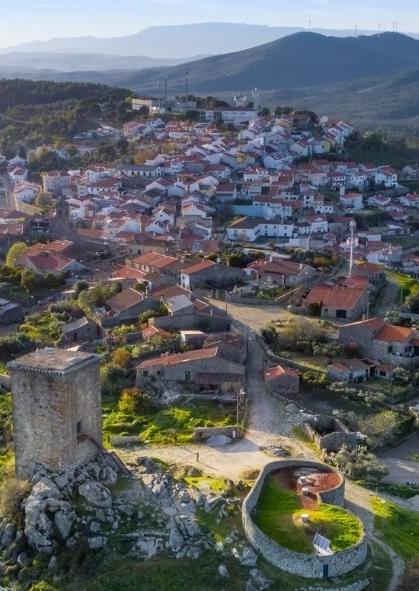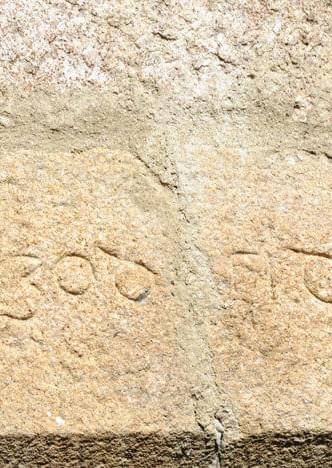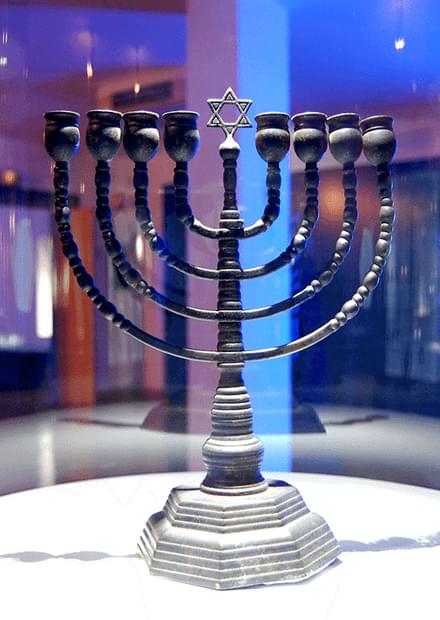The construction of the Christian Portugal has led the former Portuguese kings to have contact with the existing Jewish communities, accepting their help (they had a decisive role on King Afonso Henriques’s side when Lisbon was taken from the moors in 1147) and giving them some benefits as a reward for their help in the peopling of the territory. The communities have spread themselves in such a way that, during the reign of King Dinis (1278 – 1324), there were Jewish communes all over the country. By the end of the 15th century, around 30 000 Jews were living in Portugal. Having mainly urban jobs, they were organized in communes when the group exceeded ten families. Socially speaking, they were part, at least, of three important classes: the rich bankers, traders, financiers, physicians and public position holders, a small but economically important and privileged group; the craftsmen and the small traders; and the poor and the indigent, a small minority. All of them were forced to pay very high taxes.
Organized around the synagogue, they kept their habits and lived in their own quarters (the Judiarias), generally separated from the Christian areas by walls and gates that were closed during the night. However, these quarters could never be far because, owing to their jobs (doctors, apothecaries and traders), they needed to be in permanent contact with the population. The most important families, as they played the role of King’s financial advisers, often joined the court. They had their own rules and they could appeal directly to the King, who referred to them in documents as their own possession: “judei mei”. Each Jewish quarter was a city inside the city: they had a jail, a cemetery, and a well organized and stratified society, under the authority of the rabbi, elected by the important men and helped by several persons: notaries, clerks and cut throats who were responsible for the ritual of murdering the cattle. The top of the pyramide was occupied by the chief rabbi, who was appointed by the king and, with him, took care of all the matters concerning the communities.
Coimbra, a Jewish Route
Rua Corpo de Deus (Corpus Christi), The Old Jewish Quarter
In the Middle Age, most part of the population of Coimbra lived inside the walls, crowned by a fortress of caliph origin: there was the castle, the last redoubt of all the defensive system, the Cathedral, the Bishops’s Palace and the main parish churches. Outside the walls, we should remark the magnificence of Santa Cruz Monastery. Founded in 1131 by the canons of Saint Augustine, this Monastery has marked an absolutely fundamental period in the identity affirmation of Portugal. Santa Cruz and its monks have marked the monastic culture in Portugal, thus becoming an intellectual reference. The oldest Jewish quarter was situated close to Santa Cruz, on the steepy slopes of Corpus Christi (Corpo de Deus). The Muslim quarter was situated in front of the Monastery. Concluding, we had a Christian Coimbra, a Jewish Coimbra and an Arab one, which were disposed like vertices of an ecumenical triangle of cultural miscegenation.
In June 1139, by order of Prince Afonso Henriques, the parish of Santa Cruz was limited on the south side by the Jewish slope. On the extension of the Jewish quarter, towards the northeast, till the Almoinha Régia , (almonia regis), that later became the Quinta de Santa Cruz and is now the Avenida Sá da Bandeira, was then situated the almocávar (cemetery) and the Fonte dos Judeus (Jewish Fountain). This area wasn’t much inhabited, only being allowed the circulation of the Jewish people, once the entrance of Christian women inside the quarter was strictly forbidden and, even the entrance of Christian men was subject to many limitations. However, there was a good neighbourhood between the community and the monks of Santa Cruz, who, during the reign of King John III (1521-1557), transformed the steepy path situated on the top northeast of the Jewish quarter, which could hardly allow the passage of a man, in a street (the Rua das Figueirinhas). The written and the authorized records have no mention to the existence of gates or synagogue. As it happened in other places, this last one was, probably, in the highest place of the quarter. In the centre of the Jewish quarter there is still a small church devoted to Corpus Christi or Santa Maria da Vitória (Our Lady of the Victory), built or rebuilt in 1367, but showing today some characteristics from the 18th century.
The New Jewish Quarter
The first attempt to delimit the New Jewish Quarter was in a place called Pedreira, close to the S. Salvador Collegiate. However, owing to the strong opposition led by the canons of S. Salvador, the King would change his mind and decided to delimit the quarter in the outskirts of the Largo de Sansão, in a wet field, often affected by floods. This new quarter would grow in an area that went from Rua Direita till the Santa Justa Collegiate (on one side) and till the Largo da Freiria (on the other side). This delimitation must have been done around 1360/80. The area must have also welcome the craftsmen, who have established here, being, still today, present in the toponomy of the commercial area (Baixa).
Fonte Nova ou dos Judeus (New Fountain or Jewish Fountain)
Described in 1139 as one of the limits of the Santa Cruz parish, it was probably located at the bottom of the Couraça dos Apóstolos, in the field named “field of the Jewish fountain”, being one of the limits of the Jewish quarter. Later, it has been remodelled and the fountain we see today is a baroque construction, carefully decorated, that has been finished in 1725. It has a long inscription about its works, which has been promoted by the King’s Judge, Pedro Rodrigues de Almeida. The stairs surrounding the fountain have been designed by the Architect António Madeira Portugal and were concluded in 1986, when the fountain has been transferred from its original place, behind the Mercado D. Pedro V (King Pedro V’s Market).
Patio of the Inquisition
The Patio of the Inquisition takes its name from the buildings, with historical and architectonic value, where the Inquisition Court has worked after 1548. The houses are facing an interior patio that must have had a garden. Besides the building, that has been the siege of the Inquisition in Coimbra, the patio has also gathered the primitive College of the Arts, a cloister partially limited by 16th century ionic arcades and an interior patio, surrounded by several dependences of the Inquisition: jails, torture rooms and the houses belonging to the Inquisitors. The jails can now be seen through the thick glasses that they have as ceiling. They still keep a beauty that can be seen in the old bricks used in the ovens, in the big arches of the medium floor, or in a narrow vault that we can see in a high room and that is followed by another one, in a lower and smaller room. In one of the small rooms, we can still find a painting that is what remains of an old fresco.
With an indelible dark drawing, it shows simplified vegetal ornaments, a kind of embroidery. Before the Patio being abandoned, its houses have been used, during the first republic, as horse stables by the National Guards. They have left the sign of their passage on a graffiti, an influence of the Phrygian cap. On the noble floor, we can read, on one of the walls: Liberdade Egualdade Fraternidade (Liberty, Equality, Fraternity). The building is remarkable, not only because of its primitive architecture, but also because of the many restorations it has had, including the one that the Architect João Mendes Ribeiro has made to adapt the building to welcome the Encontros de Fotografia (Photography Meetings).
Praça 8 de Maio, Largo de Sansão
Near the Santa Cruz Church, the old Largo de Sansão was a meeting place, thus being also a place of markets and feasts. This reason, as well as its monumentality, has led it to be chosen to receive an auto-de-fé. As we know, the places where the autos-de-fé took place were carefully chosen, not only because of the protocol that included very strict matters to be treated previously, but, mainly because of the spectacularity that they presented, thus having an enormous impact on the people who watched them.
Praça do Comércio, The Praça Velha
The Praça do Comércio, Praça Velha, Praça de São Bartolomeu or simply Praça, has been the centre of the Coimbra surroundings and an important area in its life. For centuries, this square has been one of the most remarkable centres of activity in the city, and, for this reason, it has received the most part of the autos-de-fé in Coimbra. The first public auto-de-fé in the city has taken place in this place on 5th October 1567, which has condemned 27 men and 72 women, being six of the women burnt alive. But, maybe the most famous were those of 18th June 1623 and 05th May 1625. In the first one, 139 persons have been condemned, ten of them to death. Included in this number there were two nuns from the Santana Convent, Violante de Faria (arrested since 17th October 1621) and her sister, Mariana do Deserto, daughters of the Mathematics teacher, André de Avelar.
They were both condemned to prison in a convent chosen by the Inquisitors. In the same auto-de-fé, André de Avelar has also been condemned, for the second time since 17th October 1622, being condemned to life in prison without remission. Two days after, he was sent to Lisbon to serve his term. On the 4th May 1624, another auto-de-fé would take place in the same square. In this one André de Avelar’s son, Pedro Homem de Faria, who was arrested since 11th February 1621, was condemned to walk with fire “Sanbenitos” and to spend five years at the galleys, rowing without salary. On Sunday, 5th May 1625, 189 persons were condemned, including 11 nuns. Nine persons with Jewish origin have been burnt alive, being one of them a nun from the Monastery of Semide (near Coimbra).
New Cathedral
Created thanks to the Jesuits, its construction has started in 1598. Its construction has probably lasted for a century. Its facade shows the long time it has taken to be built: the first phase of lines is strongly classical and the second phase is already baroque. The saints from the Company of Jesus – Inácio, Luis Gonzaga, Francisco Xavier and Francisco de Borja – are represented in the sculptures from the first phase of the facade. It was a private church from the Colégio da Companhia de Jesus (Company of Jesus’s College), having belonged to the Order till their expulsion from Portugal, in 1759. In spite of their connection with the Holy Office, attacking heresies as well as the Jewish communities, till around 1620, this temple wasn’t directly connected with the Inquisition. However, it’s considered a symbolic space because Padre António Vieira has lived in the College close to the church, after being condemned by the Holy Office. It was also in this place that, in the afternoon of the 23rd December 1667, he was condemned, by the same court, “to have neither right to have active or passive voice, nor to preach, and to stay arrested in a house of his religion to be chosen by the Holy Office”.
University of Coimbra
Founded in Lisbon, in 1290, it was definitely transferred to the Royal Palace of Coimbra in 1537, during the reign of King John III. Also in the same period, the studies have been reformed and the university has received new Portuguese and foreigner teachers. New ways of teaching and new scientific subjects were transmitted, mainly thanks to the “estrangeirados” (the Portuguese who had travelled to other countries, getting different knowledges). But this knowledge could also be reached through the Jewish the New Christian teachers who have developed and transmitted in this University, one of the oldest in Europe, important scientific studies in several different fields like medicine, exact sciences and botany.
These characteristics have transformed the University in a “free-thought” centre, which represented a threat to the union defended by the kingdom, concerning faith, cultural and religious politics. Anything against the Council of Trent was condemned and many teachers have been pursuited, accused of homosexuality or immorality, blasphemies against the religion, Protestantism and Judaism. Many of them have been arrested, condemned or forced to leave their jobs. Very few changes have been accepted in schools and the University has just stopped its own evolution. Old methods were still used and any scientific or cultural progress was just not accepted. From those who have fought against the organized censure, very few have gone beyond the empiricism, transforming it in a clear scientific attitude.














